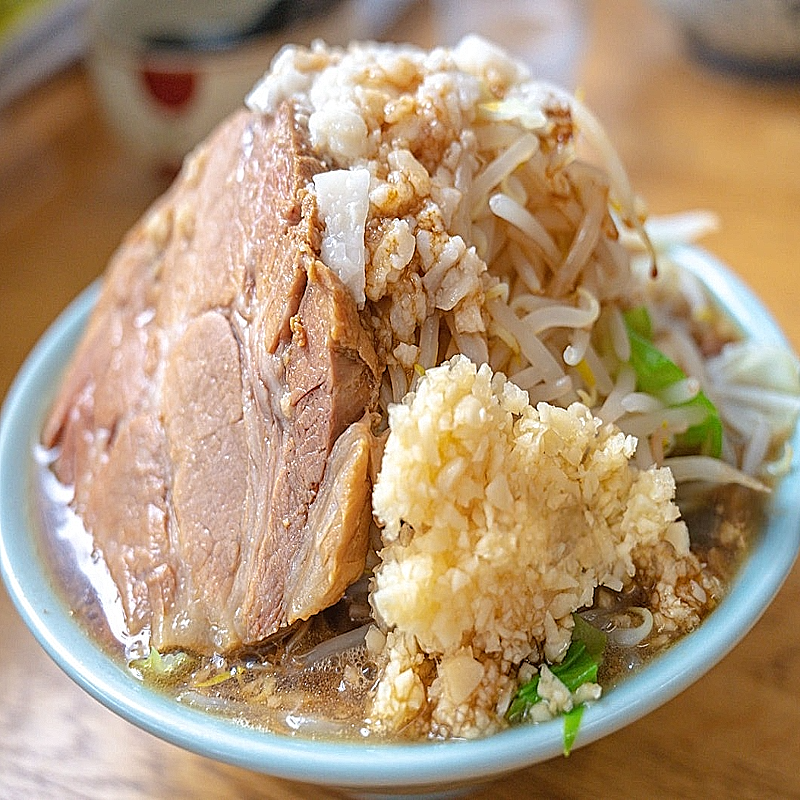Jiro-Style Ramen (二郎系ラーメン)
 Garanties sécurité
Garanties sécurité
(à modifier dans le module "Réassurance")
 Politique de livraison
Politique de livraison
(à modifier dans le module "Réassurance")
 Politique retours
Politique retours
(à modifier dans le module "Réassurance")
:
Ramen is an iconic dish in Japanese cuisine, popularized in the 1950s with the spread of ramen restaurants across the country. However, Jiro-style ramen (二郎系ラーメン) is a more recent variation that emerged in the 1970s in the Mita district of Tokyo. This style is characterized by generous portions, a rich broth (usually based on 豚骨, tonkotsu or pork bones), thick noodles, and abundant toppings. The visual appearance of Jiro-style ramen is especially recognizable: a mountain of vegetables, meat, and noodles.
Jiro-style ramen quickly gained popularity due to its reputation as a "hearty dish" and "culinary challenge," attracting a loyal following who appreciates its comforting and filling nature.
Ingredients Needed:
For the soup, oil, and pork (チャーシュー):
- 800 g pork belly (with a thick layer of fat) 豚バラ肉 (buta bara niku)
- 700 ml water
- 30 g Ajinomoto (味の素)
- 120 ml dark 醤油 (shōyu)
- 30 ml mirin (みりん)
- 1 stalk of Chinese cabbage (キャベツ)
- 120 ml skim milk
- 1 slice of mochi (餅)
- 30 ml lard (ラード, rādo) refined (to add to the bowl)
For the noodles:
- 180 g semi-dried Sanuki udon
- 16 g baking soda (重曹, jū sō) (8 g for 1 L of water)
- 6 g Ajinomoto (味の素)
- 2 L water
For the topping:
- 2 packs of bean sprouts (もやし, moyashi)
- Shredded cabbage (千切りキャベツ, sengiri kyabetsu) (to your preference)
- 1 to 2 cloves of fresh garlic (ニンニク, ninniku), minced
Preparation of the Soup and Pork (チャーシュー):
Prepare the pork: Take the pork belly and remove the thick layer of fat. The fat, cut into small pieces, will substitute for the back fat typical of Jiro-style ramen. If the fat is difficult to cut, place it in the freezer for about 15 minutes to firm it up and make cutting easier. Slice the fat into thin strips and then chop it into small pieces.
Cook the pork: Place the chopped pork belly, the cut fat, 700 ml of water, and 30 g of Ajinomoto (味の素) in a large pot or rice cooker (炊飯器, suihanki). Do not add the 醤油 (shōyu) or みりん (mirin) yet, as this would make the meat tough. Cook everything on "quick cook" mode for 31 minutes. The pressure cooking will quickly soften the meat while infusing the water with its flavor.
Add the cabbage: After the first cooking cycle, add the stalk of Chinese cabbage (キャベツ) cut into slices and the outer leaves of the cabbage to add sweetness and a vegetable aroma to the soup. Cover and return to quick cook mode for a second round of cooking.
Second cooking cycle: After the second cycle, the meat should be tender, and the fat should have melted. Remove the meat, fat, and cabbage from the pot and transfer the soup to a smaller pot.
Emulsifying the Soup:
Creating a Thick Broth: Heat the soup in a smaller pot and add 120 ml of skim milk (for emulsification), along with a slice of mochi (餅) to give it more body. Bring it to a boil and let the mochi (餅) soften to add viscosity to the broth.
Blend with an immersion blender: Once the mochi (餅) has softened, use an immersion blender (ハンドブレンダー, hando burendā) to emulsify the soup. This creates a thick, rich, and creamy broth, perfect for ramen.
Preparing the Noodles:
Cook the noodles: In a large pot, bring 2 L of water to a boil and add 16 g of baking soda (重曹, jū sō). There will be a slight fizzing, so add it slowly. Also add 6 g of Ajinomoto (味の素) to season the water. Drop the Sanuki udon (讃岐うどん) into the boiling water and cook for about 4 to 4.5 minutes. The noodles will take on a yellow hue due to the chemical reaction with the baking soda, and their texture will become firm, similar to Chinese noodles (中華麺, chūka men).
Drain and prepare the noodles: Once the noodles are cooked, drain them well and place them into the bowl where the broth is ready.
Assembly and Topping:
Prepare the topping: While the noodles are cooking, boil the bean sprouts (もやし, moyashi) and shredded cabbage (千切りキャベツ, sengiri kyabetsu) to prepare the "yasai" (野菜, vegetable toppings).
Final Assembly:
Once the soup is ready and the noodles are cooked, add 30 ml of melted lard (ラード, rādo) and 360 ml of emulsified soup to a hot bowl. Add the vegetables to the bowl, then top with three slices of pork (チャーシュー). Finish with a little minced garlic (ニンニク) and oil for a rich and savory taste.
Technique "tenchi-gaeshi" (天地返し): To better integrate the flavors, you can use the technique "tenchi-gaeshi" (天地返し), where you flip the noodles and vegetables so that the soup can properly soak into all the ingredients.
Serving:
Your Jiro-style ramen (二郎系ラーメン) is now ready to be enjoyed! You have thick, firm noodles in a creamy broth, accompanied by tender pork and savory vegetables. Enjoy hot with your personal touch of garlic and oil.
Drinks to Accompany Ramen:
In Japan, ramen is often paired with beer (such as Asahi or Sapporo) or green tea. Beer, in particular, is a popular choice for those who enjoy the balance between the richness of the broth and the freshness of the beer. Non-alcoholic drinks like iced green tea (ryokucha) are also popular, offering a slight bitterness that contrasts nicely with the sweetness of the ramen broth.
In ramen-ya (ramen restaurants), some customers also choose to drink ramen-jiru (スープ), a beverage that is simply the leftover ramen broth after eating the noodles and toppings. It's not exactly a drink, but a well-loved soup complement.
Desserts:
Traditionally, ramen is not associated with desserts in a classic meal. However, after a hearty bowl of ramen, some prefer to refresh with a light dessert, such as daifuku (大福), rice dough balls filled with sweet red bean paste, or kakigori (かき氷), a popular Japanese shaved ice dessert often enjoyed in summer, topped with flavored syrups like strawberry or green tea.
Mochi (餅), a chewy rice dough, is also a common option in homemade ramen recipes. Sometimes, a slice of mochi is added to the soup to give it more consistency and sweetness. This also recalls the texture of traditional Japanese desserts, often made with rice or rice dough.
Summary of the Homemade Jiro-Style Ramen Recipe:
In this adapted version of Jiro-style ramen, the process begins with preparing the soup, where pork belly and pork fat are simmered to create a rich-tasting base. The fat from the pork belly, as a substitute for the back fat, is chopped into small pieces to mimic the characteristic texture of Jiro ramen. The meat is then pressure-cooked to make it tender and juicy.
The noodles are a key element in this recipe: Sanuki udon, typically used in Japanese soups, are cooked with baking soda to give them the firm texture characteristic of Chinese noodles. Once cooked, they are combined with the thick, creamy broth, generous amounts of vegetables like bean sprouts and shredded cabbage, and slices of pork.
The dish is served with a savory finishing touch of minced garlic and melted lard, creating a rich, flavorful, and satisfying ramen. Although traditionally seen as a hearty meal, some Japanese people opt for a light dessert afterward, such as daifuku or mochi, to end the meal on a sweet and relaxing note.
Thus, Jiro-style ramen is not only a historic dish but also a culinary experience that can be paired with various drinks and finished off with a typical Japanese dessert. This type of ramen blends abundance and refinement while still remaining an accessible dish for all.


